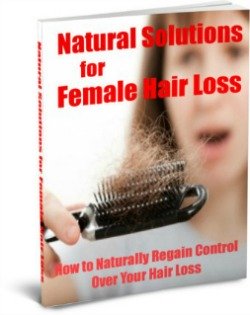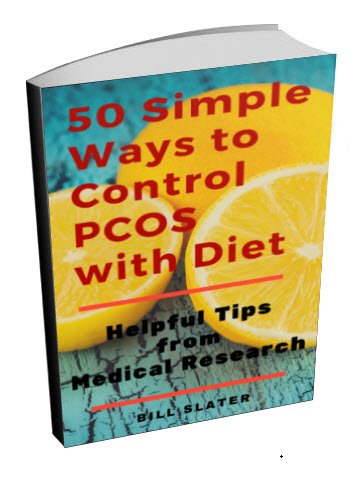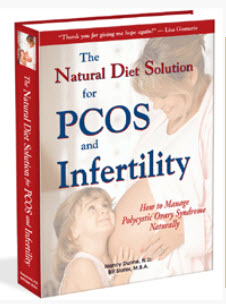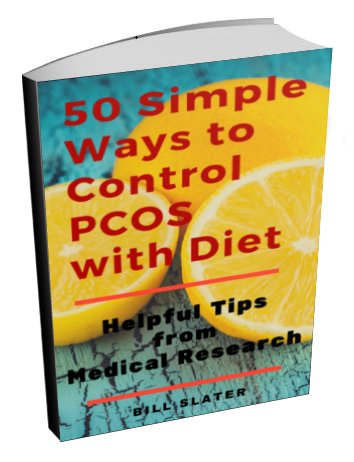Female Hair Loss and PCOS -- What's Going On?
Female hair loss results in a great deal of emotional distress, to say nothing of the other aspects of PCOS.
Much of our identity is linked to having healthy, plentiful, luxuriant hair on our heads. Our hair is an integral part of "who we are". This seems to be especially true for women, judging by the billions of dollars spent by women on hair care.
Free PCOS Newsletter
So when you start losing scalp hair, your self-identity is eroded. You are no longer the person you perceived yourself to be. You feel that you are less attractive and less desirable to others. Others may make judgments of you that are unfair or may think there is something wrong with you.
The distress is increased by a perceived inability to control and stop your hair loss. It feels like a process that is irreversible and out of control.
If this describes you, you're not alone! Fewer than 45% of women will go through life with a full head of hair.
Your doctor may not fully appreciate what a difficult problem hair loss is for you. Since hair loss isn't an immediate threat to your health, your doctor may not give it the attention it deserves.
Women who are losing their hair have reported the following problems:
- Inability to style their hair.
- Dissatisfaction with their personal appearance.
- Concern about hair loss continuing.
- Concern about others noticing their hair loss.
- Feeling self-conscious.
- Feeling jealous.
- Experiencing embarrassment and shame.
- Feeling powerless to stop their hair loss.
A few women have reported directly to us that female hair loss is the worst problem they have ever had in their entire lives!
Visible Symptoms of Female Hair Loss
The first symptom you'll notice is increasing amounts of hair in your shower drain, on your hair brush, on your furniture and clothes. It's normal to lose about 100 hairs per day. So there will always be some hair loss. But you'll just have the feeling that too much is falling out. You could be right.
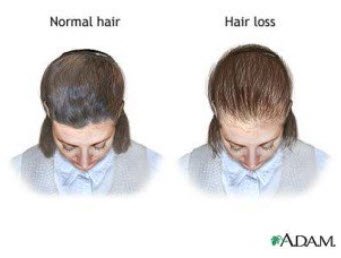
The next symptom you'll notice is that your scalp hair doesn't seem to be as thick as it used to be. Or you may be able to easily see your scalp when you part your hair.
You may experience a general thinning of hair all over your scalp.
Or you may see mild to moderate hair loss at the crown or a receding hairline, which would be similar to what a man experiences. You could also see patchy areas of hair loss.
Depending on what is causing your hair problem, the loss may be temporary, semi-permanent, or permanent.
The Hair Cycle
Hair grows in cycles. Approximately 100 hairs are lost from your scalp daily. The average scalp contains roughly 100,000 or so hairs. The hair shaft grows out of its follicle at an average rate of about one-half inch per month.
Each hair grows for two to six years, then rests, and finally it falls out. A new hair is supposed to begin growing in its place. At any particular time, about 85% of hair is in a growing phase and 15% is resting.
Loss of hair or baldness occurs when a hair falls out but is not replaced by a new hair. The loss usually develops gradually and may be patchy or diffuse (all over), depending on the type of alopecia.
The typical pattern of female pattern baldness is different from male pattern baldness. In women, the hair thins all over the head, but the frontal hairline is maintained. There may be a moderate loss of hair on the crown, but this rarely progresses to total or near baldness as it often does in men.
The reason for this is that hormone and enzyme receptor sites on a woman's scalp are located differently as compared to a man's scalp. Therefore, changes in hormone levels affect the hair follicles of women in locations that are different from men.
5 Things You Need to Know
After reviewing over 1,000 medical studies related to the topic of hair loss, we can tell you five things about hair loss.
1) It's an incredibly difficult problem to figure out in terms of causes and treatments.
2) The conventional treatments that are offered are not effective or only minimally effective for the majority of women.
3) It takes a very long time to know whether a treatment may be working or not.
4) Your hair may never completely grow back, so it's better to deal with the issue now rather than wait.
5) A comprehensive, systematic approach is required in order to maximize your probability of success. A piecemeal approach is generally not sufficient. Hair loss is a multi-faceted, very complex disorder. You need to examine and deal with each facet. If you overlook any aspect, you could fail to get the results you so fervently desire.
This female hair loss e-book offers a plan for you to deal with hair thinning in a more effective way.
Types of Alopecia
Women can have one type or more than one type of alopecia, which is the medical term for the partial or complete absence of hair from where it is supposed to be growing.
You could be affected by any one of these kinds of alopecia:
- Androgenic (androgenetic) alopecia
- Alopecia areata
- Anagen effluvium
- Cicatricial alopecia (scarring alopecia)
- Postpartum alopecia
- Psychogenic alopecia
- Telogen effluvium
- Traction alopecia
- Trichotillomania
- Lipedematous alopecia.
Since you have PCOS, the most likely type you'll have is androgenic alopecia. It is caused partly by excessively high levels of testosterone and results in female pattern hair loss.
Related Articles
- What Causes Thinning and Loss?
- Conventional Treatments
- Natural Treatments for Healthier Hair
- 25 Burning Questions Answered - Part 1
- 25 Burning Questions Answered - Part 2
Get Answers to your Questions about
- Fertility
- Weight Control
- Hair Loss
- Stress
- Unwanted Hair
- Acne...and more!
FREE PCOS Report
and Newsletter

Your email is safe with us. We respect your privacy, and you may unsubscribe at any time.
Recent Articles
-
PCOS Long Journey to The Happy End
Apr 30, 18 07:24 PM
Hi Girls, Maybe my story will have one day a good end but I am not there yet. Until I was 31 years old I lived my dream, having lovely husband, good -
PCOS and Miscarriage
Apr 17, 18 04:03 PM
Proper diet and natural supplements can help the body maintain a pregnancy through successful delivery.
-
How to Deal with PCOS and Stress
Apr 04, 18 04:19 PM
Your body has a natural capacity to heal itself if you provide it with the necessary tools.
